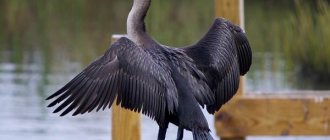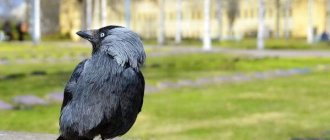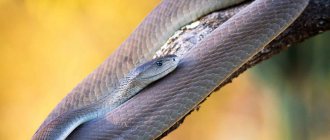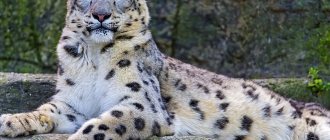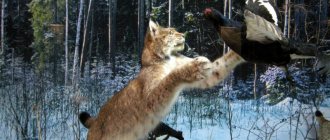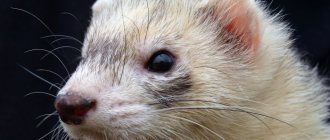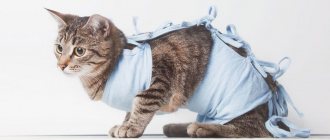- Wild animals
- >>
- Mammals
The large jerboa is an amazing animal that is famous for its unique running style. Another name for the animal is the earthen hare. These animals are the largest among all existing species of jerboas. The animal is distinguished by great caution, timidity and leads a rather hidden lifestyle. In this regard, many have no idea what kind of animal it is or what it looks like.
Origin of the species and description
Photo: Big jerboa
The great jerboa belongs to the rodentia order and is a member of the family of five-toed jerboas. According to historical data, the ancestors of modern jerboas inhabited the planet almost from the time of its settlement. It has been scientifically proven that during the Oligocene period they actually already existed on our planet, and this is 33 - 24 million years ago!
Presumably, the ancient predecessors of jerboas migrated from Asian territory to the territory of northern Africa, as well as to Europe. Today, there are practically no representatives of this species left in Europe. Externally, jerboas are very similar to ordinary gray mice. About five dozen of these amazing animals are found in nature.
Appearance and features
Photo: Animal big jerboa
Externally, large jerboas resemble gray field mice, hares, and kangaroos. They have a large, round head and a very short neck, with which it practically merges. The animal's muzzle is round, slightly elongated. She has huge, high-set, black eyes and a snout-shaped nose.
In the cheek area there are long, hard whiskers. Vibrises are designed to determine the path trajectory and serve as a kind of motion sensor. A distinctive feature of large jerboas is their huge, elongated ears, which is why they are nicknamed earth hares. The ear length is 5-7 centimeters.
Video: Big jerboa
Also, this type of animal is distinguished by powerful, developed jaws with 16 or 18 teeth. Incisors are used to crush food and also loosen soil when digging.
Body dimensions of an adult:
- Body length – 18-27 centimeters;
- Sexual dimorphism is pronounced: males are larger than females;
- The length of the tail is one and a half times the size of the body and is 24-30 centimeters;
- Body weight does not exceed three hundred grams;
- The long thin tail performs an important function - balancing while running. At the end of the tail there is a fluffy fur tuft, most often white. The tail is also a storehouse of fat deposits. They help animals survive the winter.
The animal's forelimbs are short. The hind legs are much longer than the front ones. Their size is 3-4 times the size of the front paws. Large jerboas have very powerful feet due to the fact that they move exclusively on their hind legs. The length of the foot reaches ten centimeters. The limbs are five-fingered. The first and fifth fingers are poorly developed. The three middle bones on the fingers grow together into one, which is called the tarsus. The fingers have long claws.
The animal's fur is thick and soft, has a yellowish, gray color depending on the region of its habitat. The cheek area is lighter than the body. In some individuals, the cheek area is almost white. On the outer surface of the hind legs there is a light transverse stripe of hair.
Types of jerboas
Currently, biologists know of 26 species.
The smallest species is the dwarf jerboa.
They come in five-toed and three-toed varieties.
Their body length does not exceed 6 cm.
The largest representative is the large jerboa.
It lives in steppe zones.
The body length can reach 18-27 cm.
Fat-tailed dwarf jerboa.
Lives mainly in sandy deserts.
The tail is covered with meek hair. The animal has tube-shaped ears.
Long-eared jerboa
lives in China and Mongolia. The animal's weight varies from 24 to 38 g. From a distance, this animal looks like a miniature hare.
A distinctive feature is very long ears, their size is two-thirds of the length of the body. It is not only an organ of hearing, but also of thermoregulation. This jerboa is the most eared animal on the planet.
The habitat for most species of this rodent is the deserts of hot countries.
Tarbaganchik
The following species live in Russia:
- large jerboa;
- tarbaganchik;
- hairy jerboa;
- common jerboa;
- jumping jerboa.
These animals play an important role in maintaining the desert biocenosis. In Russia, the large jerboa lives in the steppe of southern Siberia, Crimea, along the southern tributaries of the Oka and Kama.
Where does the big jerboa live?
Photo: Great jerboa Red Book
This representative of the family of five-toed jerboas lives in the steppe zones. A hundred years ago, these animals lived all the way from the west of Ukraine to the autonomous zone of China. Today, the animal’s habitat has been significantly reduced due to the destruction of its natural habitat by humans.
Geographical distribution zones of the great jerboa:
- territory of Eastern Europe;
- Kazakhstan;
- western regions of Siberia;
- the foot of the Tien Shan Mountains;
- the foot of the Caucasian mountain ranges;
- northern regions of the Black Sea coast;
- northern regions of the Caspian Sea;
- the foot of the Altai mountains.
The areas chosen for living are steppes and forest-steppes. They avoid plowed lands used for agricultural land. In such territories, jerboas cannot create a full-fledged home for themselves. They prefer areas with hard ground. You can also often find a large jerboa in the coastal areas of salt water bodies and steppe rivers. Settlement in mountainous areas is typical. Individuals can rise to a height of up to one and a half thousand meters above sea level.
Large jerboas love flat areas with sparse vegetation, meadows, and pine forests. They are considered unpretentious animals in terms of climate and weather, as well as natural conditions.
Lifestyle
The habitats of the large jerboa are diverse. In the north of its range it stays in open areas with sparse grass. In the steppe zone it is common along the sides of dirt roads, field edges, pastures, and along the gentle slopes of ravines and ravines. In the steppes of Kazakhstan and Western Siberia, it inhabits short-grass meadows with saline soils, the banks of salt lakes and steppe rivers, and the edges of pine forests. In deserts it is not found only on shifting sands; prefers areas with light loamy soils and thickets of cereals, wormwood and succulents. In the mountains it rises to 1650 m above sea level.
Leads a solitary lifestyle, rarely contacting relatives outside the breeding season. In captivity, adults show aggression towards each other. The large jerboa is active exclusively at night, emerging to the surface 40-45 minutes after sunset and returning to the hole 30-50 minutes before sunrise. Compared to small jerboas, it is more careful - before leaving the hole, the animal sniffs and listens for a long time. In a calm state, the large jerboa moves on its hind legs at a walk or trot. When running, it switches to asynchronous ricochet (successive pushes, first with one paw, then with the other). The length of a normal jump is 80-125 cm; maximum running speed is 40-50 km/h. Large jerboas do not make sharp jumps when running and escape from pursuit with smooth but powerful jolts, creating the impression that the jerboa is literally flying above the ground.
The large jerboa digs complex permanent (summer and wintering) and simple temporary burrows. A permanent burrow begins with a passage densely packed with earth, running almost horizontally; its length can reach 6 m. From the horizontal passage in the middle, an inclined passage extends steeply downwards, which leads to the nesting chamber at a depth of 40-110 cm. At its other end, the main horizontal passage opens outwards. The entrance used during the day is usually blocked with an earthen plug. Branches may branch off from the main passage, slightly below the surface of the earth and serving as emergency exits (usually 1, rarely 2-4). The spherical nest in the chamber is made of dry blades of grass, moss, wool, down and feathers. Winter burrows are deeper (1.5-2.5 m), with two nesting chambers at different depths. Temporary burrows are shallow, in the form of a passage slanting underground. In the north of its range, the jerboa also settles in empty gopher burrows.
Nutrition
The large jerboa is an omnivorous rodent - its diet may equally contain plant (seeds, roots, bulbs) and animal (insects) food. He easily switches from one type of food to another depending on its availability and time of year. On agricultural lands, the large jerboa often collects sown seeds of watermelons and melons, and also feeds on grains of cultivated cereals, sunflower seeds, and peas, but causes little damage.
What does the big jerboa eat?
Photo: Big jerboa
Large jerboas are considered herbivores. It is noteworthy that the appearance of the tail indicates the abundance of food, health and condition. If the tail is thin and the vertebrae are visually visible, the animal is exhausted and lives practically from hand to mouth. If the tail looks round and well-fed, the animal does not experience a lack of food. Every day an animal needs to consume at least 50-70 grams of food, depending on its weight.
The basis of the diet of a large jerboa is:
- Cereals;
- Insect larvae;
- Fruits;
- Seeds;
- Roots of various types of vegetation.
It is noteworthy that these small animals do not drink water. They consume the required amount of liquid from vegetation. Jerboas are able to travel long distances in search of food. They move mainly along previously surveyed paths. Capable of walking up to ten kilometers. Animals love to eat goose onions, seed peas, steppe bluegrass, melons, and watermelons.
Animals are not very picky about food. In the absence of their favorite ingredients, they can eat almost anything that comes their way.
They are considered a very important part of the natural habitat in which they live. They distribute seeds throughout the territory of their movement and control the number of insects in this area. However, at the same time they can be carriers of dangerous infectious diseases. Diet can vary significantly depending on the season. In spring, they prefer to eat young shoots and lush green vegetation. If there are agricultural areas nearby, they dig up the fields in search of seeds planted in the ground.
Features of character and lifestyle
Photo: Great jerboa (ground hare)
The large jerboa is a solitary animal. They tend to be most active at night. During the daytime, they mostly hide in made shelters - minks. They rarely leave them during daylight hours. Jerboa burrows are horizontal corridors 5-6 meters long. At the end of the corridor there is an extension in the form of a nesting chamber.
In the northern regions, gophers often occupy vacant houses. The depth of the shelter is determined by seasonality. In summer and spring, holes are dug at a depth of 50-110 centimeters, in winter - 140-220 centimeters. During daylight hours, animals cover the entrance hole to their shelter with earth. The long tunnel has several spare entrance holes that open almost on the surface of the earth.
The main role in the construction of shelters belongs to the front incisors. The limbs perform an auxiliary function. The excavated soil is moved with the nose, in the same way as in pigs. Large jerboas hibernate. They hide in a hole to hibernate with the onset of cold weather and the first frosts. Hibernation ends at the end of March.
Fat reserves concentrated in the tail area allow you to endure the winter period. During this period, some individuals lose up to 50% of their body weight. It is noteworthy that after waking up, the animals' ears droop. They rise only when blood circulation and muscle tone are restored.
Jerboas tend to lead a solitary lifestyle. It is noteworthy that they take root well in captivity. Cases of domestication are common, and sometimes a person gets two or more individuals that get along well with each other. Jerboas move exclusively on their hind limbs. They trot and can move by pushing off alternately with one and the other lower limbs. The tail maintains balance and acts as a rudder. Jerboas are capable of running very fast.
They are considered one of the fastest runners. They reach speeds of up to 50 km/h, and are able to run at this pace for more than two kilometers. It is characteristic that large jerboas hold records for high jumps. With their height, they jump up to three meters in height, which is almost ten times the length of their own body. Animals are naturally endowed with acute hearing and sense of smell.
Description of the jerboa
Small, mouse-like mammals. They are representatives of the rodent order . There are about 50 species in nature. The most famous include: African, five-fingered, large jerboa, marsupial, long-eared, bushy-legged, fat-tailed, and also the jumping jerboa.
Appearance
Externally, jerboas resemble either a kangaroo or a mouse. The head is large relative to the body, with an almost indistinguishable neck. Round, slightly flattened muzzle with large dark eyes. Large eyes allow you to capture a greater flow of light information.
Huge fan-shaped vibrissae. This is the main organ of touch in many animals. As a rule, they have long and rounded ears, which carry the function of heat transfer and reception of auditory information. The hair on the ears is sparse.
Reference:
- Body length: from 4 to 26 cm.
- Tail length: from 6 to 28 cm.
- Weight: from 10 to 300 grams.
The body is short. The hind limbs are much longer than the front ones, which is necessary for active running. The animal uses short forelimbs with sharp, elongated claws for digging holes and manipulating food. The fur is thick and soft. Color ranges from sandy to brown, mostly monochromatic. There is a light color on the belly.
The jerboa's tail may contain a reserve of fat necessary to maintain the body during hibernation or during periods of lack of food.
The tail has a flat tassel at the end, which acts as a kind of rudder when moving. Individual characteristics of color and limb structure depend on the species and habitat. For example, the color and size of the body as a whole or its individual parts change.
Lifestyle and behavior
The jerboa is a nocturnal animal. Wary to such an extent that after sunset it leaves its hole only an hour later. Searches for food all night, going up to 5 km away.
And in the morning, exactly an hour before sunrise, they return to the shelter. Such reinsurance often saves lives. However, there are species that are active and search for food during the day, and at dusk they rush to their house underground.
One type of housing is summer. With separated rooms covered with grass. Often, practical animals make a “back door” in their underground apartments and, if threatened, escape through it.
In winter, the animal goes into hibernation, which lasts up to six months. A hibernation hole differs from a regular “living” hole. It is located much deeper, reaching 2.5 meters. Some species store food reserves for the winter, while others store them directly within themselves, in the form of fat.
Jerboas are real builders. These hardworking animals build more than one house for themselves. They have summer and winter holes, permanent and temporary, a hole for hibernation and holes for the birth of offspring.
Also, these incredible creatures can have houses for permanent and temporary stay. Permanent houses always have an entrance covered with a clod of earth. This peculiar corridor is quite long deep into the interior.
Next, as a rule, a branch appears leading to the living room, in which the surface is covered with grass and there is a place for a “bed” in the form of a ball of wool, moss, feathers - all suitable materials collected on the surface. Several unfinished passages already lead from it to the surface. They are necessary in case of emergency evacuation.
Among the jerboas there are those who, instead of building their own house, “rent” it from the gophers. The jerboa contacts its relatives only during the mating season. You can call him a loner. This is one of the strategies that are used for survival by different representatives of the flora.
Some stay in a group and survive, having a developed system of communication and coherence among themselves. And some, on the contrary, prefer to develop individually, passing on the genes of the most adapted, fastest, invulnerable, cautious and intelligent to the next generation.
And if the individual turns out to be clumsy, slow or inattentive, then it dies. This ensures the survival of the species.
How long do jerboas live?
However, diseases, the influence of natural conditions and predators shorten this time significantly. In captivity, lifespan increases significantly. The average life expectancy in the wild is no more than 3 years.
Social structure and reproduction
Photo: Animal big jerboa
The mating period begins with the end of hibernation. The beginning of this period is considered to be the end of March, the beginning of April. The mating period continues until autumn. Under favorable conditions, jerboas are capable of producing offspring up to three times a year. This fecundity allows for the rapid restoration of endangered populations in some regions. Pregnancy lasts a short period of time - 25-27 days. One female is capable of giving birth to from 1 to 6-7 babies. Most often, offspring appear in the spring.
The cubs spend the first one and a half to two months in a shelter with their parents. At the end of this period, they begin to lead a separate lifestyle. The cubs understand that it is time for them to separate from their parents when the female becomes aggressive and no longer shows concern. The signal for such behavior is a lack of space in the burrow, as well as a significant increase in the weight of the offspring. Individuals that have reached 5-7 months of age are considered sexually mature. The female takes on the bulk of the care for the offspring.
Females prepare a place for birth by digging a separate burrow. The cubs are born completely helpless. They see nothing, they have no hair. Outwardly, they resemble baby rats.
Reproduction and offspring
Jerboas reach sexual maturity at the age of 6-7 months. And if they survive safely until this period, then the breeding season begins in the first spring or summer. The duration of pregnancy depends on the subtype, but on average it lasts no more than one month.
The female bears 2-3 litters per year. One litter contains from 3 to 8 babies. For childbirth, jerboas create a separate burrow. From birth, the cubs are blind and bald, very similar to rat pups.
It’s also interesting how the female understands that “the time has come.” She, of course, has neither a clock nor a calendar. Most likely, the innate mechanism starts from the moment when babies begin to weigh 200-220 grams.
The mother cares for and protects the offspring for up to 3 months. Then her behavior changes dramatically. She becomes aggressive. This is how kids understand that the time has come to live independently.
A change in weight and a decrease in living space in the burrow tell the mother that it is time to let the cubs go “free swimming.” She begins to show aggression, bite, drive away food.
Natural enemies of the great jerboa
Photo: Big jerboa
Under natural conditions, these small rodents have many enemies.
Natural enemies:
- Reptiles;
- Snakes;
- Predator birds;
- Some species of lizards;
- Wolves;
- Lynx;
- Foxes.
Despite the fact that jerboas lead a hidden lifestyle and only come out at night, they often become prey to predators. The greatest danger to jerboas is posed by snakes, as well as owls, which hunt mainly at night. Rodents have excellent hearing and a keen sense of smell. Thanks to this, they are able to sense danger when it is still far away. Feeling a threat, the animals quickly run away. Special shelter burrows help them avoid danger.
Human activity is rapidly reducing animal populations. The development of territories and the destruction of the natural habitat of rodents leads to the destruction of animals.
Population and species status
Photo: Baby large jerboa
In general, it cannot be said that the rodent species is on the verge of extinction. However, on the territory of Russia and Ukraine, these animals have been practically exterminated. In many regions of Russia, the large jerboa is listed in the Red Book: Moscow, Lipetsk, Tambov, Nizhny Novgorod regions. It has been assigned the status of a vulnerable species.
